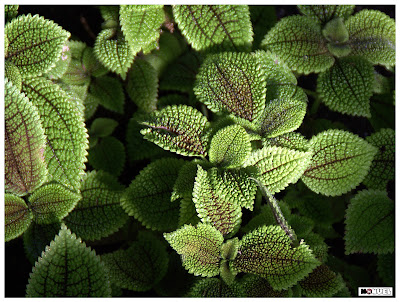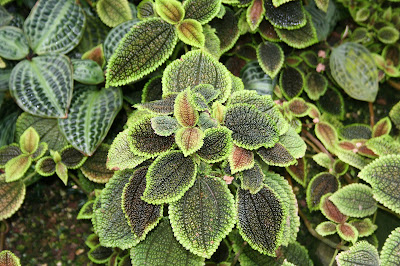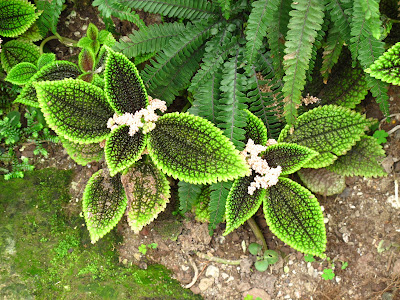Pilea mollis - Moon Valley plant is found in La Guajira (Colombia); Aragua, Venezuela Distrito Federal, Miranda (Venezuela)...
Pilea mollis also called as Moon Valley plant, Adicea mollis, is a species in the genus Pilea. This species was described by Hugh Algernon Weddell in 1856. The specific epithet means soft or with soft hairs.
IDENTIFY PILEA MOLLIS - MOON VALLEY PLANT
Pilea mollis is native to Central and South America. It is found in La Guajira (Colombia); Aragua, Venezuela Distrito Federal, Miranda (Venezuela).
It is a bushy trailing plant which will remain relatively small, never reaching more than 12 inches in height. The leaves are ovate, toothed, textured, dark green with dark bronze undertones and often light green edges. Leaf undersides are typically dark red.
Moon Valley plant blooms in summer with tiny pink-green flowers in branched cymes that are not particularly showy. There is some confusion as to which species this Pilea belongs. Sometimes it is listed as mollis and sometimes involucrata. But, there should be no confusion as to the identity of this distinct plant.
PILEA MOLLIS - MOON VALLEY PLANT CARE AND CULTURE
Cultural information should only be used as a guide, and should be to be adapted to suit you. Your physical location; where you grow your plants, how much time you have to devote to their care, and many other factors, will need to be taken into account. Only then can you decide on the cultural methods that best suit you and your plants.
Light:
Pilea mollis do best in a bright, indirect sunny spot in your home. Even though this plant is part of the succulent family, do not place your plant in direct sunlight since it will scorch the leaves. In order to prevent your plant from growing lopsided, rotate it at least 2-3 times a week since it grows towards the sun. This plant can adapt to lower light areas, but the leaves will turn a darker green and the plant will spread out more.
The leaves that have been exposed to too much direct sunlight will sunburn and turn yellow. Trim sunburned leaves off of the plant and move the plant to a shadier location immediately.
Temperature:
Normal household temperatures between 65-75 °F (15-23 °C) are fine. However, make sure that your Pilea does not sit near the heating vents in the winter, as it will drop its leaves. They shouldn’t normally survive temperatures lower than 50°F (10°C) in winter. It is best to grow the plant indoors, since, indeed, the slightest frost will kill it.
Substrate and growing media:
Moon Valley plant grow best in smaller pots or planters where their roots will be somewhat restricted, choose a new pot that’s just one or two inches larger in diameter than the old pot. They should be planted in a peat moss based commercial potting mix with leaf mold and perlite added. Check the root density every spring, if the roots are becoming overly dense, transplant the plant to a size larger pot. If you do not, the root system will break the container in an attempt to find more room to grow.
Watering:
Isn’t too fussy about humidity, and although its leaves are succulent-like, it prefers more water than a cactus. Like a lot of succulent plants, it is prone to root-rot, so allow the soil to dry between waterings, as Pilea do not like soggy soil. Watch the leaves - when they start looking a tad droopy, it’s time to water your plant. During spring and summer, the top quarter inch of the soil should be kept moist. During fall and winter, allow the top quarter inch of soil to dry out before watering again.
If you notice white spots on your plant, they are most likely caused by salts and chemicals in your water. If you do not have a filtration system, leaving the tap water in an open container overnight before watering can help remove some of the chlorine and fluoride.
Fertilizer:
For best results, use a general liquid houseplant fertilizer at half strength twice during the spring and summer. Do not fertilize a dry plant; instead water it first and then fertilize the next day.
If a white crust develops on the soil, it’s a sign of fertilizer salt build up. If this occurs, hold off on your fertilization for a few months. In addition, make sure you’re flushing water through the pot each time you water. Evidence of salt buildup also shows up as a white crust on the outside of terra cotta pots.
Pruning:
Pinch the terminal stem (the topmost one) between 2 fingernails to force the plant to start branching out. If you wish for the plant to keep a bushy bearing and grow as many branches as can be, simply keep pinching young shoots off after a bud.
Blight (plant disease) can occasionally set up in a plant. It will usually begin in one leaf, turning it brown and rotten. Remove this stem from the plant to prevent it from spreading to the entire plant.
Propagation:
Pilea mollis is super easy to take cuttings from, as it has the ability to grow roots and plantlets from almost every part of the plant! The easiest way is to take a leaf (with the petiole attached) from the mother plant, let the end dry out for a day or two, and then put it in a little glass of water, and watch and wait! Keep the water clean and make sure that the leaf isn’t allowed to dry out, and in 1-2 months, you should start to see new growth


















COMMENTS